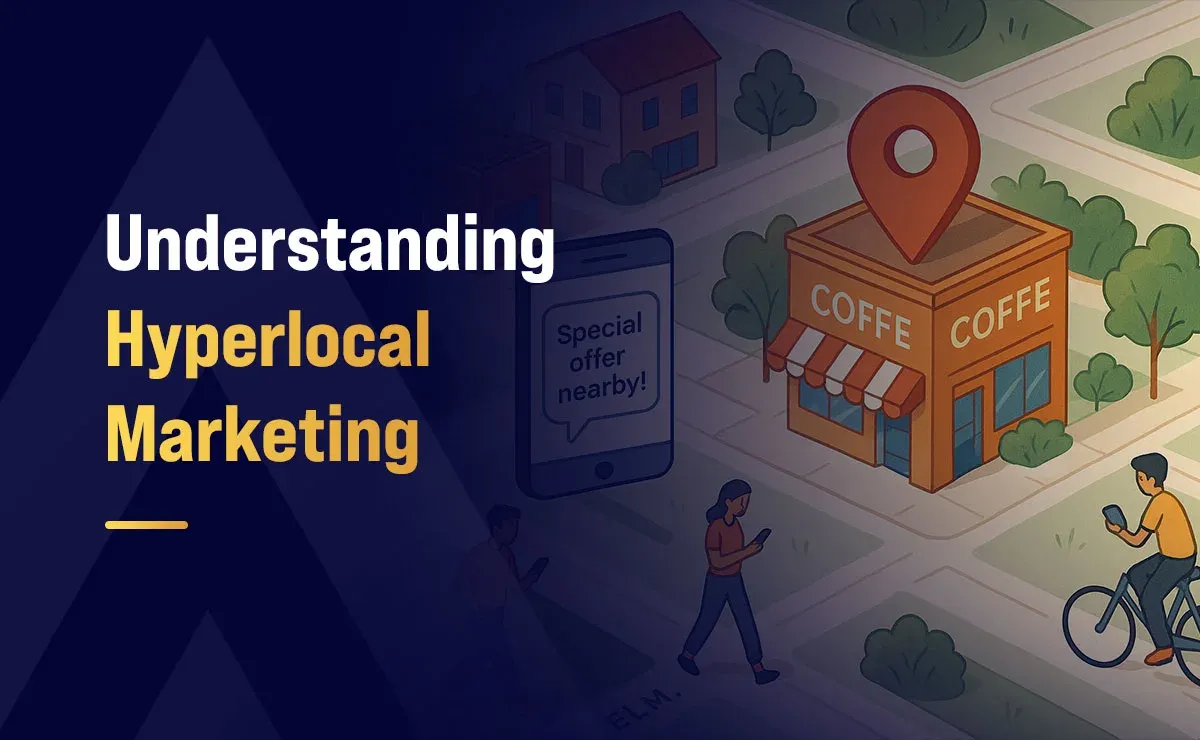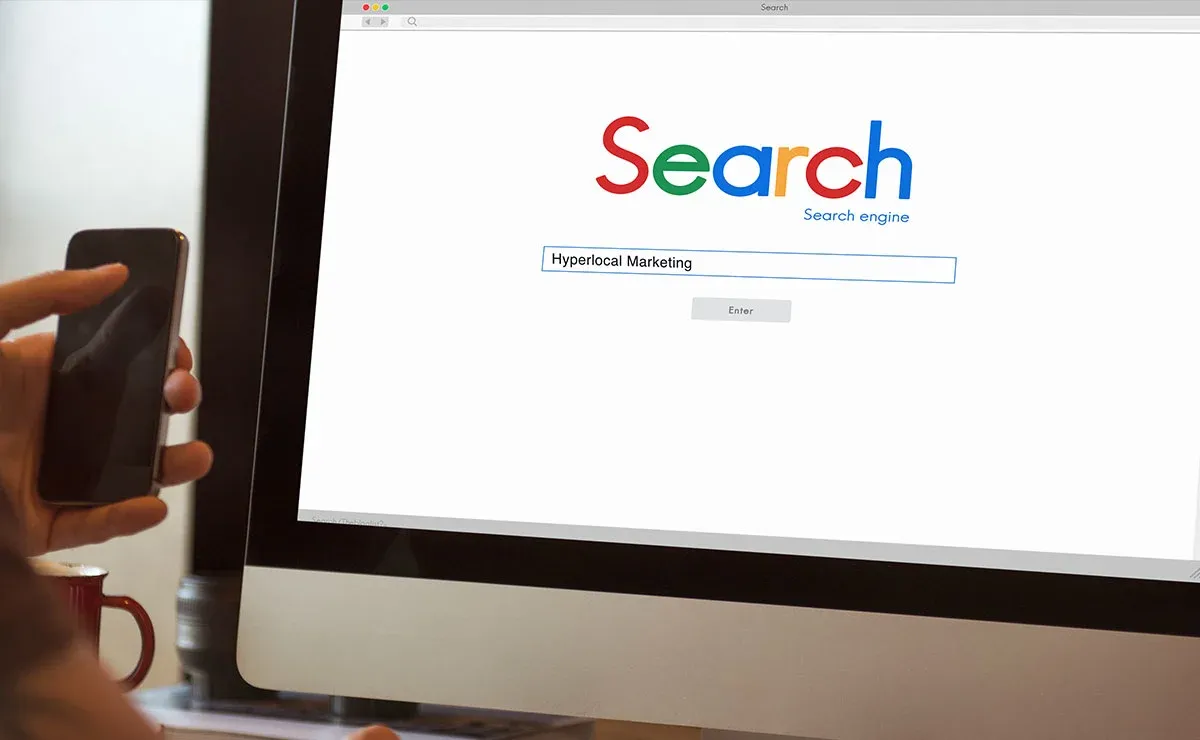Understanding Hyperlocal Marketing

Imagine you just opened a small coffee shop in your neighborhood. You serve the best cappuccinos in town but are struggling to grab customers' attention. Running a big national ad campaign might seem like the next logical step in this situation, but to be very real—most of your customers are going to be people who live or work nearby.
Today smartphones are almost an extension of us, which provides the opportunity to utilize strategies like hyperlocal marketing, fitting perfectly in the situation mentioned above.
Instead of spending big on national ad campaigns that might miss the mark, hyperlocal marketing targets a very specific geographic area—think neighborhoods, blocks, or even streets—to engage consumers when they’re most likely to take action.
What is Hyperlocal Marketing?

Hyperlocal marketing focuses on engaging consumers within a specific geographical radius—typically encompassing just a handful of roads, a residential district, or a single urban block. This approach aims to reach local buyers precisely when they seek relevant offerings in their immediate vicinity.
Hyperlocal marketing has become even more powerful due to mobile devices, as when people search for businesses near them, companies that show up at the right place win big.
In fact, according to Google, “near me” searches have skyrocketed in recent years, with more consumers relying on search engines to find nearby stores, restaurants, and services.
Why is Hyperlocal Marketing Important?
For small businesses, hyperlocal marketing levels the playing field against big corporations with massive ad budgets. Instead of trying to reach the entire country, businesses focus on the people who are most likely to visit them. This means:
- More relevant customers: By making your advertisements more personal and in line with local demands, hyperlocal marketing raises the likelihood that customers will interact with and convert through your ads.
- Cost Efficiency: By focusing on a particular region, companies can cut down on unnecessary advertising expenditure and make sure that every scope of marketing spending reaches prospective clients who are more likely to visit and make a purchase.
- Higher Conversion Rates: Local consumers looking for items or services in their area are more likely to have immediate intent, resulting in faster decision-making and a better possibility of conversion.
- Stronger Community Connection: Businesses increase loyalty by interacting with local events, culture, and trends, resulting in a more personalized approach that resonates with customers and enhances brand trust.
- Competitive Advantage: Small businesses can outperform huge corporations by combining personal service, local familiarity, and real-time involvement to stand out in a competitive market.
Effective Hyperlocal Marketing Strategies
To maximize the impact of hyperlocal marketing, businesses must use strategies that engage local customers effectively. Below are some of the most powerful techniques to drive local awareness, foot traffic, and sales.
Optimize Your Business Listings
One of the simplest yet most crucial steps in hyperlocal marketing is ensuring your business is easily discoverable online. Digital platforms such as Google My Business (GMB), Yelp, and Facebook, along with various local directories, enable businesses to become visible during proximity-based searches when nearby consumers seek services. For multi-location businesses, create individual landing pages for each location to further boost local search performance.
Utilize Mobile and SMS Marketing

Since nearly everyone carries a mobile device, SMS marketing can be an effective tool. Text messages have a high open rate and can deliver time-sensitive offers or event notifications directly to your customers’ phones. Picture broadcasting a "Midday Meal Deal" notification to individuals within a brief stroll of your location—creating an immediate incentive for action.
Create Localized Content
Create messaging that resonates specifically with your local audience. This could include blog posts, social media updates, or email newsletters that mention local landmarks, events, or even local slang. For instance, if your town is known for a particular festival or has unique local lingo, integrate that into your messaging to resonate better with your audience.
Leverage Geo-Targeted Advertising
When using platforms like Google Ads or Facebook Ads, set up geo-targeted campaigns that only display your ads within a certain radius of your business. For example, if you run a restaurant, target ads to people within a few miles or even neighborhoods. This targeting method optimizes advertisement delivery to reach those individuals most probable to step through your doors.
Experiment with Out-of-Home (OOH) Advertising
Although digital methods are prominent, traditional out-of-home advertising like local billboards, bus stop ads, or digital displays in high-traffic areas can still be very effective. With modern digital out-of-home (DOOH) advertising, you can even adjust your campaigns in real time based on factors like weather or foot traffic, ensuring maximum relevance.
Local SEO & Voice Search Optimization
Local search engine optimization helps businesses achieve superior positioning when nearby consumers initiate service-related searches. Strategies like voice search (e.g., “Where’s the best bakery near me?”), leveraging user-generated content, and enhancing website content with local keywords and long-tail phrases further optimize a local brand in the search engine.
Offer Localized Discounts & Promotions
Exclusive deals for local customers can increase brand loyalty and foot traffic. Check-in deals for customers who tag the business on social media, flash sales targeting local events or community celebrations and loyalty programs rewarding frequent local shoppers can create a stronger connection with the community and boost repeat business for the brand.
What Ranking Signals Matter Most for Hyperlocal Search Results?

The effectiveness of hyperlocal marketing initiatives largely hinges on a business's ability to secure prominent positions in location-based search results. Google evaluates several key performance indicators (KPIs) to determine which businesses appear in local searches and map results.
- Relevance: Google’s goal is to show users the most relevant businesses based on their search terms and intent. To improve relevance, businesses must optimize their Google Business Profile (GBP) and website content with the right categories, keywords, and descriptions.
- Proximity: A business's actual geographic position relative to the searcher significantly influences local search rankings. Establishments situated nearer to the person conducting the search typically receive higher placement.
- Prominence: Google evaluates a business’s overall reputation and authority to determine rankings. This is heavily influenced by customer reviews, backlinks, brand mentions, user engagement, and getting featured on high-authority local sites.
- User Engagement: Google tracks how users interact with a business online to determine its popularity and value. The more engagement a business gets, the higher it ranks.
What Businesses Benefit Most from Hyperlocal Marketing?
Businesses that depend primarily on neighborhood clientele and in-person visits benefit most substantially from hyperlocal marketing strategies. These businesses include:
- Restaurants & Cafes: Attracts nearby diners searching for “best coffee shop” or “lunch near me” with local SEO, Google My Business (GMB) optimization, and location-based ads.
- Retail Stores & Boutiques: Helps drive in-store visits by targeting shoppers with geo-targeted ads, SMS promotions, and local directory listings.
- Personal Services (Salons, Spas, Gyms): Optimized Google Business Profiles and location-specific keywords boost visibility for customers seeking convenience.
- Healthcare Providers (Dentists, Clinics, Therapists): Local SEO, patient reviews, and targeted PPC ads ensure top ranking for searches like “dentist near me.”
- Home Services (Plumbers, Electricians, Cleaners): Service-based businesses thrive on proximity; Google Ads, local citations, and emergency service keywords help attract clients.
- Real Estate & Property Management: Localized SEO, blog content on neighborhood living, and targeted digital ads help reach homebuyers and renters.
- Event Venues & Entertainment: Geo-targeted social ads and local partnerships drive awareness for theaters, museums, and event spaces.
- Automotive Services (Dealerships, Repair Shops, Car Washes): Mobile ads, GMB optimization, and local SEO improve visibility for car-related searches.
FAQs
Q1. What does hyperlocal mean?
Ans: Hyperlocal refers to a highly specific geographic area, such as a neighborhood, street, or small city zone. In marketing, it means targeting customers within a very close radius of a business to drive foot traffic and local engagement.
Q2. What is hyperlocation targeting?
Ans: Hyperlocation targeting is a digital marketing strategy that uses GPS, Wi-Fi, and mobile data to deliver ads, promotions, or content to users based on their precise real-time location, ensuring highly relevant and timely outreach.
Summing Up
In conclusion, hyperlocal marketing represents a transformative approach for small enterprises, delivering an economical and precisely targeted method for establishing connections with customers in close proximity By focusing on a specific geographic area, you can attract more relevant customers, increase conversion rates, and build stronger community ties—all while competing with larger businesses on a more level playing field.
Ultimately, hyperlocal marketing is about being present and relevant in the moments that matter to your local audience. By embracing these strategies, you can turn your brand into a neighborhood favorite, ensuring long-term success and a loyal customer base.





